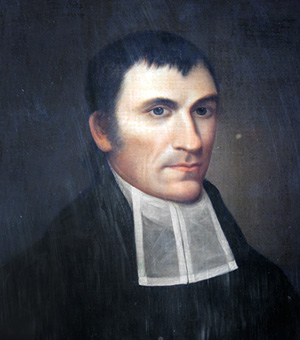Ira Condict
Queen’s College President Pro Tem, 1795 to 1810

Born in Orange, New Jersey, on February 21, 1764, Condict prepared for the ministry in his hometown and in Newark. He graduated from Princeton in 1784 and received his license from the Presbytery of New Brunswick in 1786. For six years he served as pastor of the Presbyterian Churches of Hardwick, Newtown, and Shappenock before he was installed over the Reformed Dutch Church at New Brunswick in 1794, the position previously held by Jacob Rutsen Hardenbergh. A tall, muscular man, with black hair and prominent features, Condict labored with zeal and perseverance in conducting the affairs of the church.
With suspension of collegiate work in Queen’s College, Condict turned his attentions to assuring success in the grammar school and originating plans for reopening the college. The grammar school prospered but the college remained idle; the trustees did not meet until 1800 and then very infrequently thereafter until 1807, when interest in the college was renewed. The two men most responsible for this resurgence were Andrew Kirkpatrick, former teacher in the grammar school and Chief Justice of New Jersey, and the Reverend Condict. Kirkpatrick urged the trustees to raise funds for the erection of a new college building. The trustees resolved to raise $12,000 to “complete the necessary buildings, re-establish the college and its courses of instruction, and raise it to that pitch of publick utility which the present view of things seems to encourage.” Condict procured over $6,000 for the building in 1807 from patrons in and around New Brunswick and continued his efforts during the early construction of the building.
Ira Condict was a devoted friend and zealous participant in the revival of the college. On April 27, 1809, at a formal ceremony, Condict laid the cornerstone for Old Queens.
On April 27, 1809, at a formal ceremony, Condict laid the cornerstone “with his left hand, in consequence of suffering a temporary lameness in his right.” The college had acquired a gift from the family of James Parker, constituent of the Provisional Congress before the Revolution and a leading member of the Board of Proprietors, consisting of five acres bounding Somerset and George streets, the present site of the Old Queens Campus. In addition to raising funds and supervising construction of Old Queens, Condict agreed to teach the junior class in 1808 and the following year instruct the senior class. The lower classes remained with the grammar school until the fall of 1809, when the trustees selected Condict’s son, Daniel Harrison, as tutor for the students in their first and second years. Five students appeared before the president pro tem to receive their degrees in 1809, the first commencement held since 1795. On that day the trustees offered the presidency of the college to Ira Condict, but he declined the offer. The trustees, realizing that his service was sorely needed, asked him to be vice president and professor of moral philosophy, and to continue general superintendence of the college. Though rejecting the vice presidency, Condict agreed to teach moral philosophy and to accept the supervision of the institution.
After repeated efforts, the trustees finally secured the appointment of the Reverend John Henry Livingston as president of Queen’s College in April 1810. One year later, Ira Condict died of yellow fever on June 1, 1811, at the age of 47. The college had lost another leader, a devoted friend and zealous participant in the revival of the college in 1807. Condict did not live to see the completion of Old Queens, but his memory lives within that magnificent edifice.
This biographical sketch was authored by Thomas J. Frusciano, Rutgers University Archivist. It originally appeared in The Journal of the Rutgers University Libraries.

